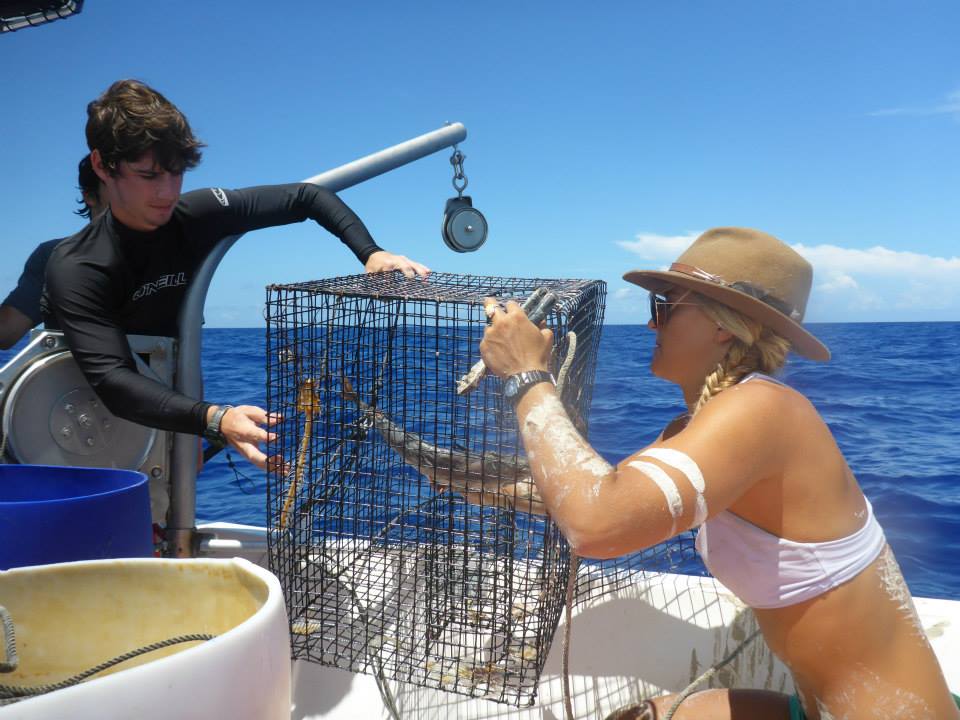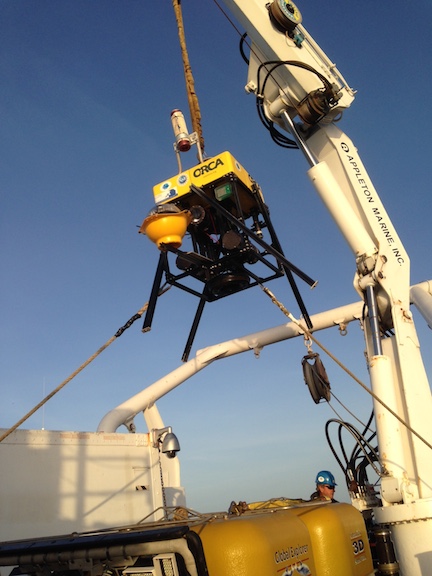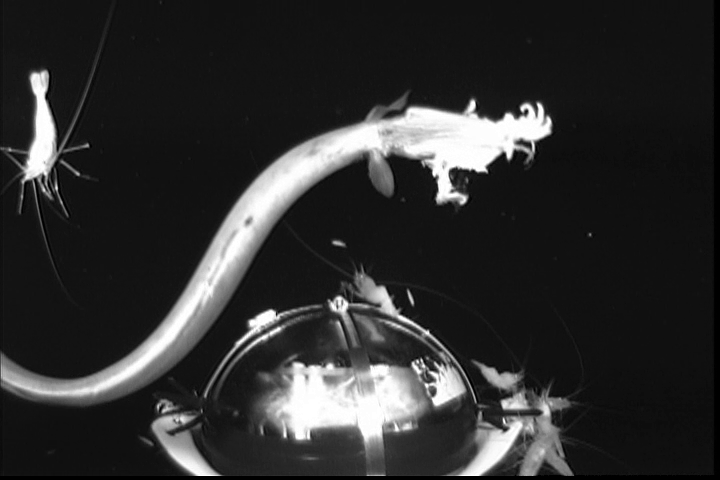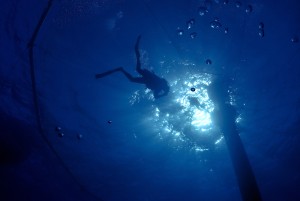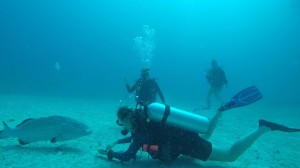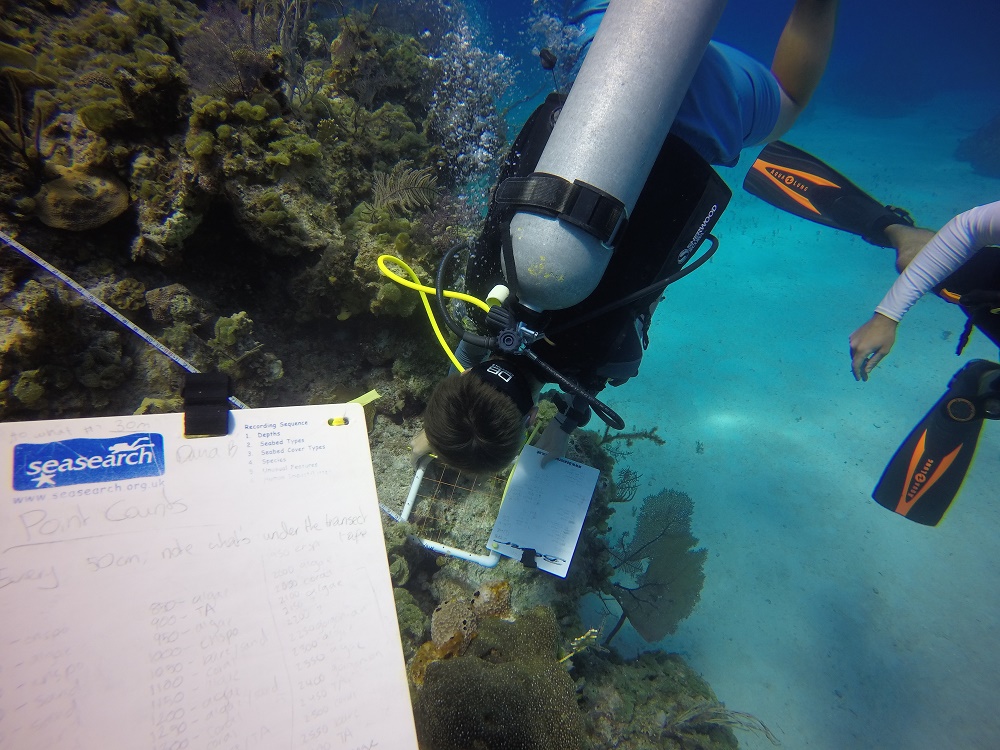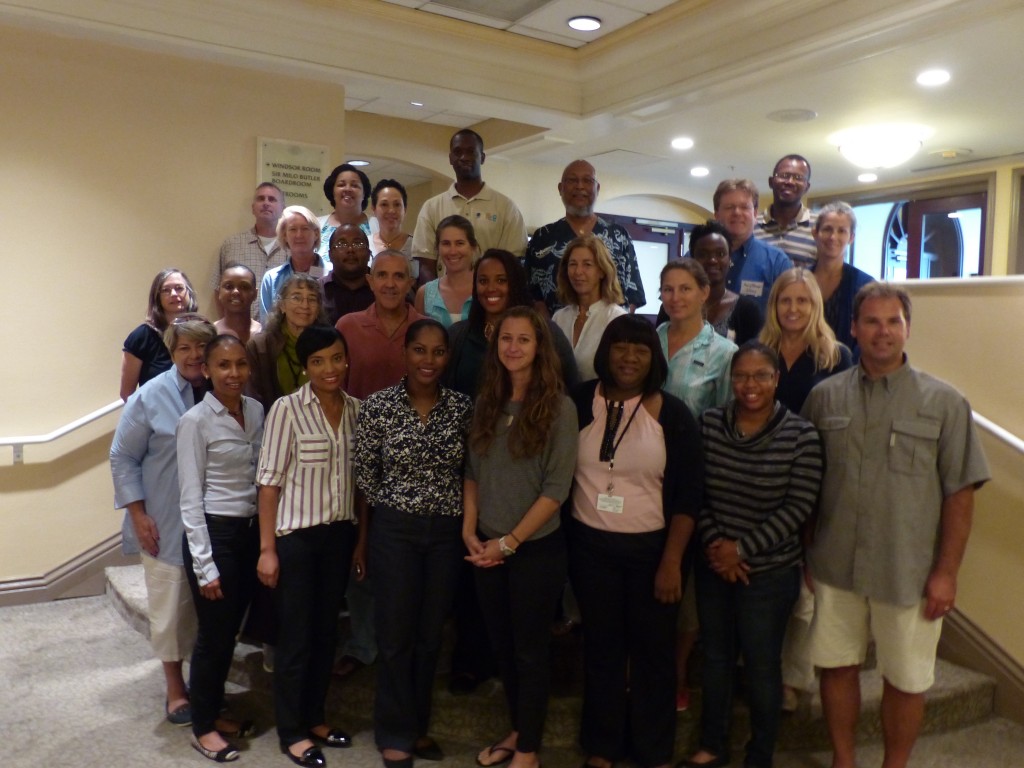On August 7th at three o’clock in the afternoon, while conducting benthic surveys on Ike’s reef, some of our summer interns came across the annual spawning event for the Brown Encrusting Octopus sponge (Ectyoplasia ferox). These common bright orange tubular sponges immediately caught their attention because they appeared to be smoking. When the interns took a closer look the smoke appeared to be stringy neon orange mucus attached to the sponges.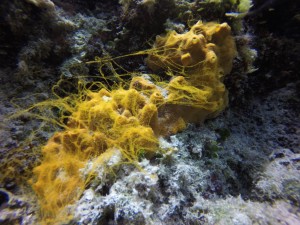
The mucus filaments contain fertilized eggs that hatch into larvae and settle down on the reef to form new sponges. The Brown Encrusting Octopus Sponge, like most sponges, is a hermaphrodite; meaning they function as both sexes simultaneously. Fertilization takes place within the sponge once sperm makes its way through the water column to an individual of the same species. August is the usual time for the spawning of this species and a number of variables make it hard to predict the exact date to witness this unique event. These sponges are generally found on coral reefs and other nearby areas at depths from 40 to 75 feet, so keep an eye out this month!
Category Archives: Research Programs
Flyfishing, snorkeling and exploring South Eleuthera with Flats Week!
This past week, Flats Ecology and Conservation Program of the Cape Eleuthera Institute welcomed four students to our campus for Flats Week. Lead by Aaron Shultz, CEI director, and Georgie Burruss, Flats Ecology and Conservation Program research technician, as well as the summer interns, Connor Gallagher, Emilie Geissinger, and Chase Goldston, the group spent the week conducting research, flyfishing, snorkeling, and exploring South Eleuthera.
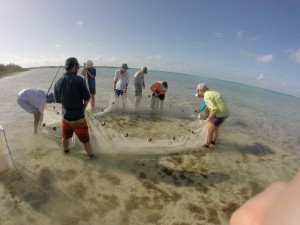
Two of the students learned how to fly fish for the first time. The group fished for bonefish for two days on the flats of South Eleuthera with Manex, a local bonefishing guide from South Eleuthera, and ended up successfully landing several bonefish. The group assisted with the Bahamas Initiative bonefish tagging program, founded by the Bonefish and Tarpon Trust (BTT), Fisheries Conservation Foundation (FCF), and Florida Fish and Wildlife Conservation Commission (FWC). A genetic sample was also taken from each bonefish caught as part of a genetic connectivity study by Dr. Elizabeth Wallace (FWC), Christopher Haak (University of Massachusetts Amherst). The Flats team spoke with the students about the controversial proposed regulations for managing the bonefishing industry in the Bahamas. The team highlighted the need for regulation of the bonefish fishery in the name of conservation.
The group contributed to research with Carleton University’s Cooke Lab graduate student, Petra Szekeres, looking at how light pollution effects adult bonefish and learning how to conduct chase to exhaustion experiments. They also assisted Petra in catching over 30 juvenile bonefish to return to CEI for experiments, making it one of the most successful days yet for juvenile bonefish collection. They spent a day at a local pond, assisting the Inland Pond Project as well as flyfishing.
The students snorkeled blue holes, learned about their formation and also saw several southern stingrays and many fish species. The students ended their week with a short down island trip, traveling to the banyan tree, the Rock Sound ocean hole, and the bat caves, focusing on how tourism and development has shaped South Eleuthera.
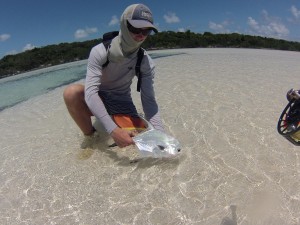
If you are interested in participating in Flats Week in August 2016, please visit the CEI short courses webpage.
Mackey recounts her deep-sea adventures with Dr. Edith Widder in the Gulf of Mexico
My journey started as an Island School student back in Fall 2006, before Cape Eleuthera Institute even existed. The bridge across the mangroves was just being built. After my semester ended I knew I wanted to do more research and come back to The Island School. I looked for any opportunity to come back. I returned multiple times, as a Dive Master, Alumni advisory, Intern, Research Technician, Research Assistant, and now as a graduate student. I been able to grow within the organization with endless opportunities and experiences to learn from. I have gone from being a student to now teaching students for the past four semesters.
My research is looking at the abundance and biodiversity of the deep-sea organisms living in the Exuma Sound. I use two specialized deep-sea cameras, the Medusa and the Pegasus. These cameras can be deployed to over 1000 meters deep and observe the animals that live in deep-sea environments. As some of the smaller organisms are extremely hard to identify on the video, I also use a series of deep-sea traps to study smaller benthic organisms.
I just got back from an amazing experience on a deep-sea cruise in the Gulf of Mexico with Dr. Edith Widder. The main focus of the cruise was finding new species that emit light through the process of bioluminescence. We had the Medusa on board, accompanied by the E-jelly, an electric jellyfish that emits small lights to replicate bioluminescence. These lights were used to lure deep sea organisms to the camera. We saw cutthroat eels, rattails, and shrimp on the film. As part of our research we collected samples of organisms that would potentially produce bioluminescence.
It was an unbelievable experience and I’m so excited to continue to research the largest and least explored biome in the world!
Flats Ecology and Conservation team removes fishing line from black grouper at 90 feet!
Sometimes all it takes is a few minutes with a trusting grouper to realize our impact on the ocean and how we can make a difference. This week, the Flats Ecology and Conservation Team at the Cape Eleuthera Institute went to retrieve a temperature logger located at the base of the Aquaculture Cage.
Located 90 feet deep near the wall of the Exuma Sound, the Cage serves as an aggregation spot for large marine creatures. Many fishermen frequent the area to catch large jacks, snappers, and groupers attracted to the cage.
Within minutes, a well-known large black grouper, affectionately named Bradley, approached the divers. Bradley came quite close to the group, turning and showing multiple hooks, wire leaders, and weights hanging from his jaw and gills. He moved in closer as Kelly Hannan, a University of Illinois graduate student, took out a pair of scissors.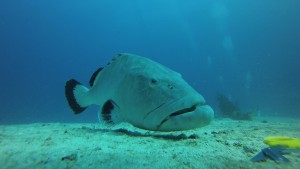
Bradley investigated the scissors and seemed to decide that Kelly was not a threat. He let her cut off two feet of tangled wire leader and three fishing weights that were hanging from the right side of his mouth. Unfortunately, the scissors were not strong enough to cut the hooks out, but the team hopes to return to the Cage with wire cutters to remove them from Bradley’s jaw in the near future.
Bradley seemed to understand that no harm would come to him from these divers and was very calm throughout the procedure. He continued to follow the divers throughout the rest of the dive.
Later that week, at the same dive site, the Flats team removed over 50 feet of fishing line from a nearby reef. Another wire trace with lead weights was picked up near the base of the Cage.
Although these dives had positive outcomes, they serve as a reminder of the impacts of fishing pressure and pollution on the marine environment. Thanks to Bradley, we had a very personal reminder of our relationship with the ocean and how our actions can affect the lives of the creatures that live in it.
Students conducting dissertation projects at CEI this summer
This is the 4th year that CEI has been collaborating with Newcastle University, United Kingdom, in offering research placements for their marine biology undergraduate students. Over the years student numbers have been increasing and this year we have 10 students enrolled in an 8 week session that provides an opportunity for them to each get hands on field and lab experience as well as collect data that they will go on to analyze. This fall they will write up a dissertation that contributes to their final university degree. This placement program has also expanded to more universities and this summer we welcomed a student from Reading University, UK, and Green Mountain College in Vermont as well as Master’s students. The ten students this summer are working on a range of studies withing our shark, coral, flats and sea turtle research programs and here is some information from three of the participants about their projects:
“Hi, I’m Jordan Atherton from Newcastle University, England, conducting research here at CEI for my final year thesis project. I’m looking at how the fish assemblages on the coral reef here are affected by different habitat complexities by method of underwater visual census, so plenty of diving!” 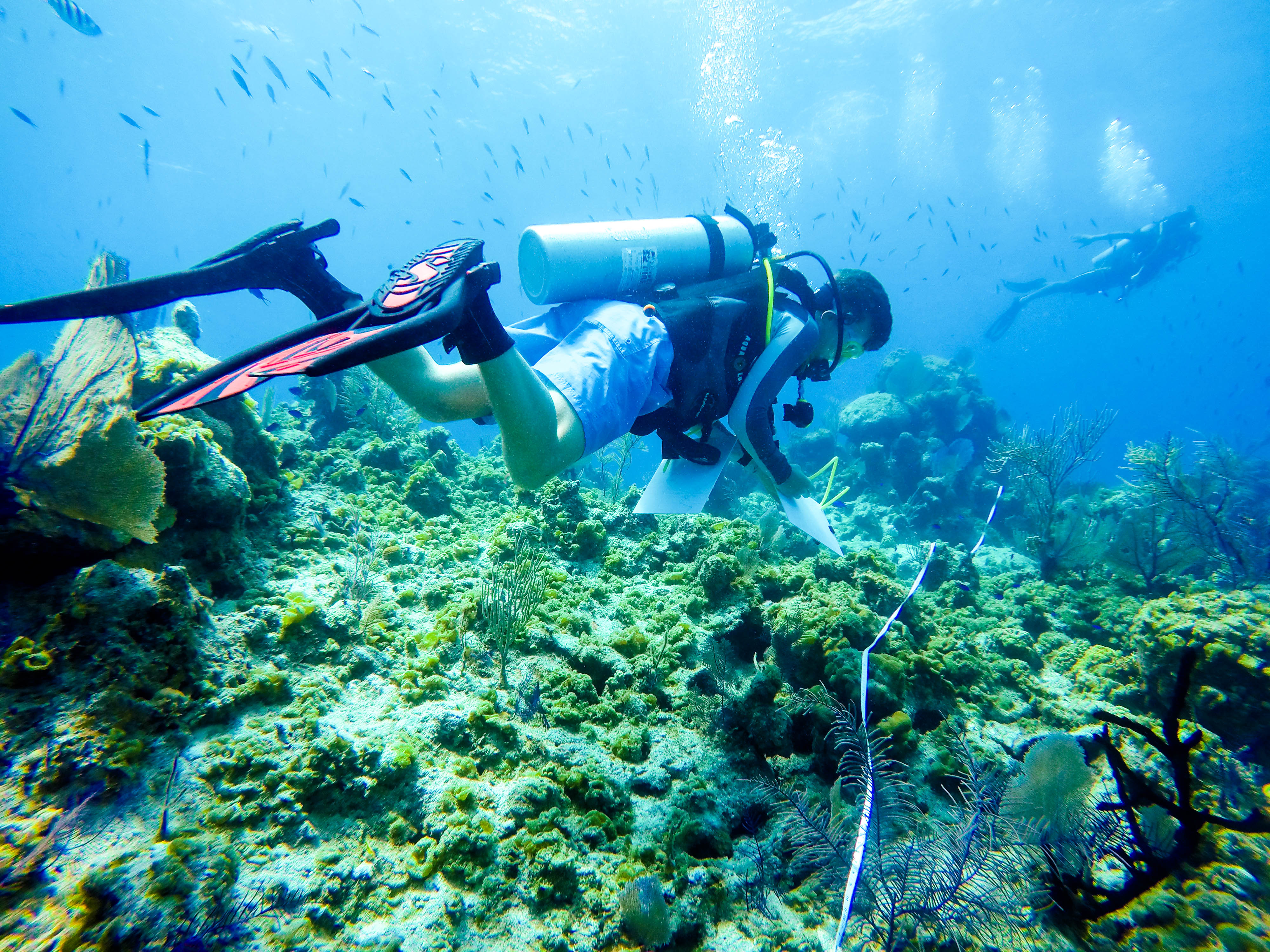 “My name is Ashley Bairos and I am conducting field research towards an M.Sc. degree from Green Mountain College in Vermont. Ultimately the goal is to measure habitat suitability across various intertidal creek areas around Cape Eleuthera for the purpose of applying effective conservation strategies for green sea turtles (Chelonia mydas). By measuring benthic coverage, predation pressures, habitat structure, and various abiotic factors including water depth and substrate type, I hope to quantify the value of foraging habitats for green sea turtles.”
“My name is Ashley Bairos and I am conducting field research towards an M.Sc. degree from Green Mountain College in Vermont. Ultimately the goal is to measure habitat suitability across various intertidal creek areas around Cape Eleuthera for the purpose of applying effective conservation strategies for green sea turtles (Chelonia mydas). By measuring benthic coverage, predation pressures, habitat structure, and various abiotic factors including water depth and substrate type, I hope to quantify the value of foraging habitats for green sea turtles.”
“My name is Izzy Lake and I am a marine biology student currently studying at Newcastle University, England. I’m here over the summer to work as part of the Sea Turtle Research Team at the Cape Eleuthera Institute. While I am here I will be conducting my undergraduate research project on understanding the environmental variables that could affect green sea turtle abundance. My field work involves conducting benthic mapping transects in local tidal creeks as well as monitoring sea turtle abundance.” 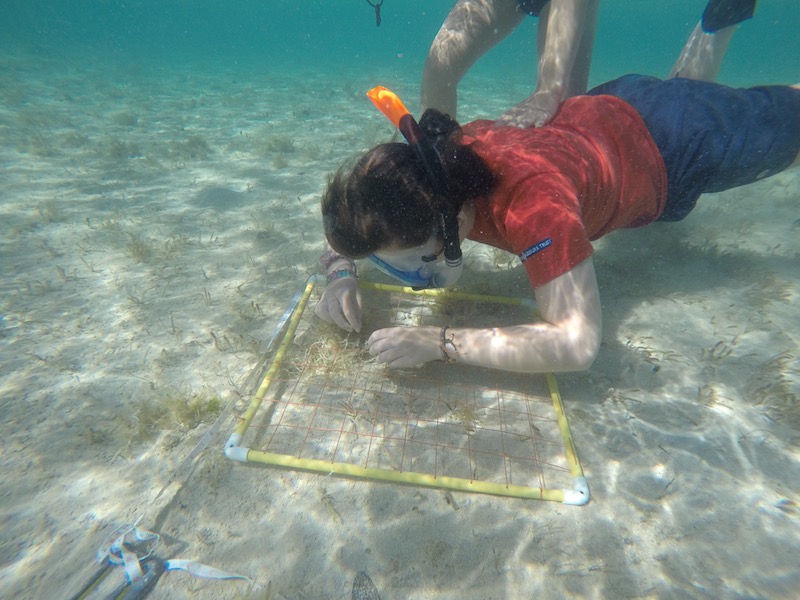 We’re looking forward to the results of their work. Any enquiries about this program should be directed to annabellebrooks@ceibahamas.org
We’re looking forward to the results of their work. Any enquiries about this program should be directed to annabellebrooks@ceibahamas.org
CEI Research Assistant works with sea turtle hatchlings in Costa Rica
For two weeks in early July, Rachel Miller, Research Assistant for the Sea Turtle Research and Conservation Program, headed to Costa Rica to lead a marine biology summer camp. This camp was comprised of 8 high school students from all over the United States who came to Costa Rica to learn more about worldwide sea turtle conservation initiatives and to help better the community.
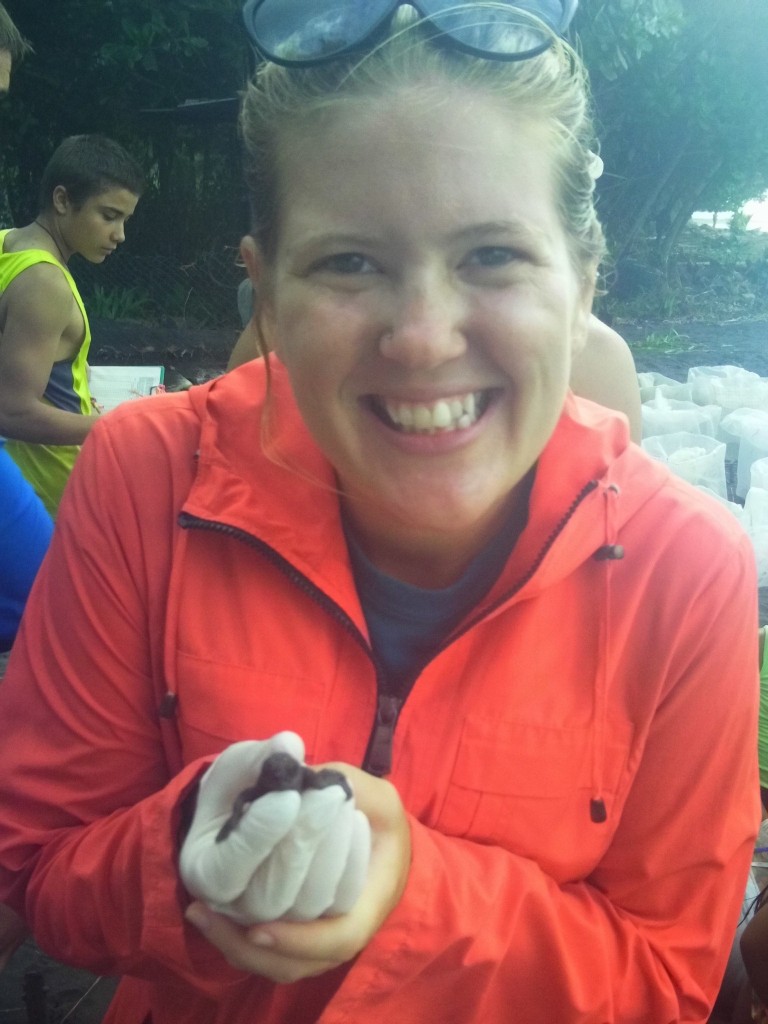
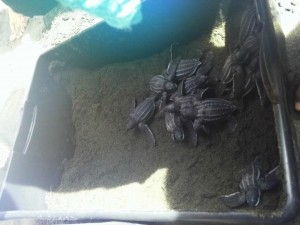
The camp worked in conjunction with WIDECAST – Pacuare, a conservation program located on the Caribbean coast of Costa Rica. Here, Rachel and the campers had the opportunity to assist with hatchery construction, night walks, and hatchling releases. Even though it is illegal, poaching is a major issue in Costa Rica, especially in poorer communities. These communities have subsisted on the consumption and sale of turtle eggs and meat for decades. However, WIDECAST – Pacuare is working to combat poaching through the use of night walks (led by former poachers, used as an alternative source of income), a guarded hatchery (used to monitor relocated nests and protect the eggs from predators and poachers), and education initiatives (public hatchling releases, lectures, and social media).
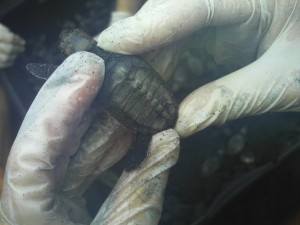
During their time in Pacuare, Rachel and the campers got to see leatherback hatchlings make their way into the sea and on the last day, they were rewarded with a hawksbill hatching! It is common for leatherbacks to nest on the Caribbean coast of Costa Rica from February until the end of June and the babies begin to hatch in May until the end of July. Hawksbill sea turtles, however, nest less frequently, and there were only two hawksbill nests in the hatchery during the time the camp was taking place. Not only was the hawksbill hatching special in and of itself, but the nest consisted of 9 hybrid hatchlings– these babies were the result of a successful mating between a hawksbill and a Kemp’s Ridley. Unlike most hybrids, the offspring of a hawksbill and Kemp’s Ridley are thought to be fertile and it is believed that this is the fourth generation of these hybrids. The reason that all 120 hatchlings were not hybrids is because many sea turtle nests have multiple paternities, resulting in typical hawksbill hatchlings and hybrid hatchlings.
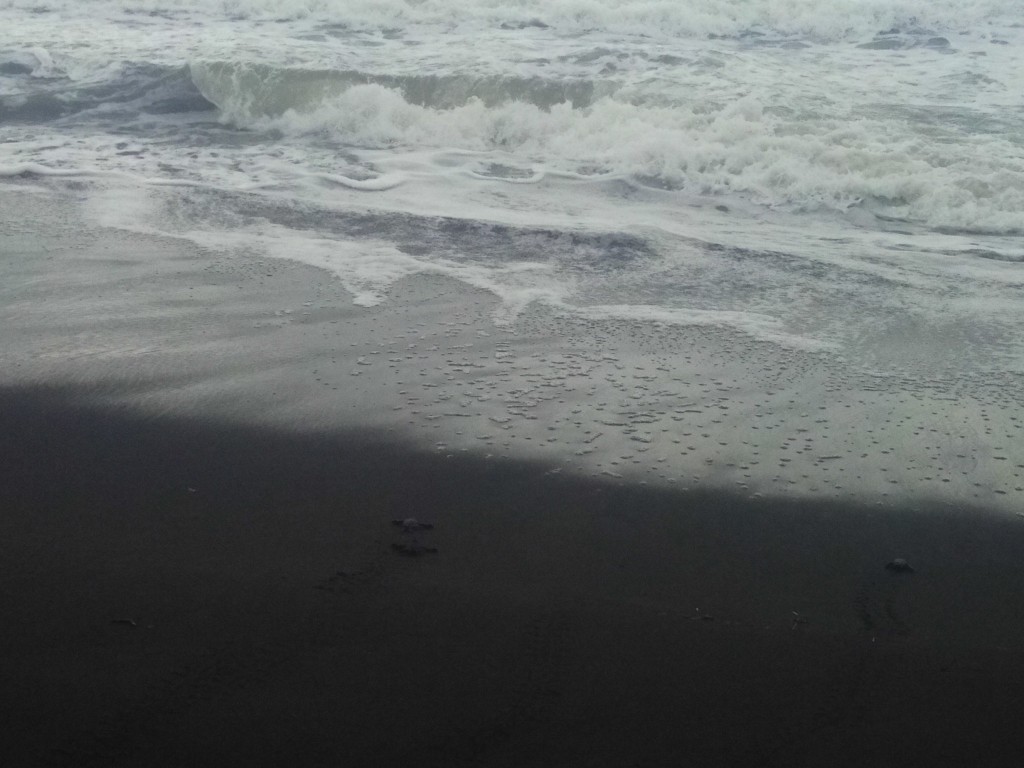
Rachel and the campers came away from this trip with a better understanding of how conservation works outside of the United States. It is often difficult to enforce laws and regulations, especially if people are reliant on an organism for food or income and if that community has no other source of income. Sea turtle populations continue to be exploited, but conservation efforts are in effect worldwide, and protecting eggs and nesting mothers helps to aid in the redevelopment of healthy sea turtle populations on a global scale. For more information on the project in Pacuare, click here.
Summer update from the Reef Ecology and Conservation Program
With the arrival of the summer interns, undergraduate and postgraduate placement students several weeks ago, CEI researcher Dr. Jocelyn Curtis-Quick has been able to tackle many different projects this summer. These projects include propagating corals at the nursery, filleting over 150 pounds of lionfish, conducting reef monitoring and conducting parrotfish feeding studies.
During March 2014, CEI installed a coral reef nursery at Tunnel Rock in collaboration with the University of Miami RSMAS and NOAA’s Atlantic Oceanographic and Metrological Laboratories and CEI Research Manager Annabelle Brooks. In the face of rapid coral population declines, growing coral through nurseries has been an initiative to replenish wild coral. The team measured the growth progress and refragmented the coral that has been steadily amassing at CEI’s nursery.
Fragmentation of coral refers to splitting of coral to help increase coral colonies and therefore increase reproduction. Half of the fragments were re-attached to the coral nursery at Tunnel Rock, and the other half were set up at a new nursery site closer to The Island School. This summer, the team will compare the growth and survival rates of the coral at these two different sites. The long-term goal is to transplant the coral frags out on the reef.
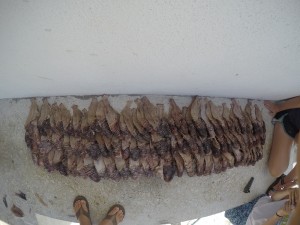
This summer the team is also being kept busy with the success of the Slayer campaign and has filleted over 150 pounds of lionfish- and has over 200 lbs to do! Over the past couple of weeks, a few local fishermen have delivered hundreds of pounds of lionfish for CEI’s “You Slay, We Pay Campaign.” These lionfish are also dissected to examine gonad development and stomach content, which can offer important insight on the invasion impacts.
Additionally, the team prepared for parrotfish behavioral research this summer. This prep has involved dive teams using a herding technique to catch the juvenile parrotfish, as well as setting up raceways in the lab to conduct a feeding behavior experiment.
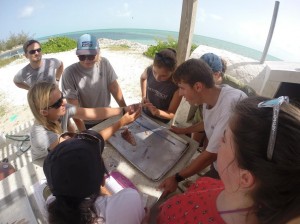 A few other exciting events include three of the reef interns completing their Advanced Diving Certification and starting on their Rescue, as well visit of a teenager Earthwatch group who assisted with research for a week. Additionally, working with The Island School students to sample inland ponds and dissection lionfish was great fun. The whole team is pumped for the rest of the summer and getting much more achieved.
A few other exciting events include three of the reef interns completing their Advanced Diving Certification and starting on their Rescue, as well visit of a teenager Earthwatch group who assisted with research for a week. Additionally, working with The Island School students to sample inland ponds and dissection lionfish was great fun. The whole team is pumped for the rest of the summer and getting much more achieved.
Graduate student update: Matthew Smith
Matthew Smith is a Master’s student of the Ecology and Environment Lab from the University of Exeter in the UK. The main focus of his study is the effects of anthropogenic noise on reef fish populations, vocalisations and behaviour. There have been many studies on the effects of anthropogenic noise on marine mammals, but substantially fewer studies have be conducted concerning how noise pollution is affecting reef fish. Hearing and vocalisations are very important to many species found in the patch reefs such as those off of the coast of Cape Eleuthera. Boat traffic is an emerging threat that is often forgotten when assessing the threats to marine populations.

The primary study has involved selecting pairs of patch reefs with similar characteristics before splitting the pair into either treatment group, to receive increased or reduced boat traffic. By conducting fish surveys at regular intervals and recording using a hydrophone, Matthew is able to decipher if the changing levels of boat traffic is having an effect on the community living on each patch reef.
A secondary study is looking at the effect of boat traffic on damselfish (Stegastes spp.). Damselfish aggressively defend territories within which they preen a ‘garden’ of algae and have a heavy influence on algae populations on reefs as well as the behavior of fish in and around their territories. Using reefs that are less frequently exposed to boats, cameras are set up in front of damselfish territories to record how exposure to boat traffic affects their behavior. The end goal is to be contribute towards a better assessment of how anthropogenic noise pollution is affecting fish populations.
Sea Turtle Earthwatch Team visits CEI
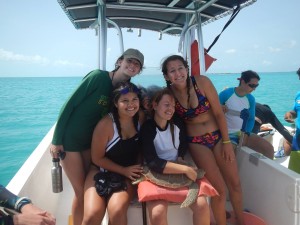
The Sea Turtle Research Team recently said goodbye to their first Earthwatch team of the summer, and we are sad to see them go. The group of 7 students and 4 chaperones from Santa Maria, California were very enthusiastic and eager to participate in all activities. The group’s visit was concurrent with the summer intern’s first week at the Cape Eleuthera Institute, so lots of learning was had by all. Our work done in the field with Earthwatch included abundance surveys, BRUVS (baited remote underwater video survey) setting, as well as catching and tagging turtles through seining and capture off the boat. Jules, a fast swimming student from the Earthwatch team, caught the first turtle, named ‘Seawater,’ setting the mood for the week to come. Our most successful turtle capture was on the last day, with a total of 10 turtles caught in our seine net at Half Sound! With one recapture and 9 new individuals being tagged, it added a significant amount of turtle individuals to our overall count with sizes varying from 257mm- 357mm.

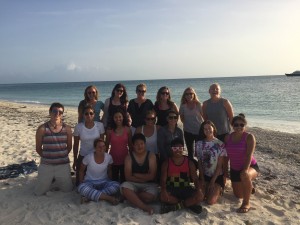
Other highlights of the week included excursions to the ocean hole and caves in Rock Sound as well as a down island trip with lots of stops along the way. On a day off, the team got to see a bit more of Eleuthera, stopping at the Glass Window Bridge, and Governors Harbor. Evenings consisted of presentations given by Cape Eleuthera Institute faculty about their research including information on sea turtles and manta rays. They also spent two evenings recording data from the BRUVS they had set out earlier in the day by watching the film and looking for predators and they saw- barracuda, nurse sharks, and even a green turtle. “I genuinely will miss this place and will cherish everything forever,” said Eugene Kim, one of the student volunteers as his closing remarks. Our next group arrives at the end of July!
CEI Research Manager attends Coral Reef Strategic Planning Workshop
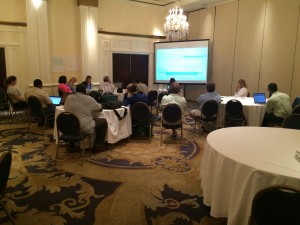
The Bahamas National Trust invited the Cape Eleuthera Institute to participate in a Strategic Planning Workshop intended to develop a national strategy for improving the health of coral reef ecosystems and species that depend on them. The workshop took place June 23rd – 26th at the British Colonial Hilton in Nassau and was led by Dr. Craig Dahlgren. The aim of the meeting was to incorporate knowledge of island-specific and national issues, threats, and current or planned activities into the overall strategic plan.
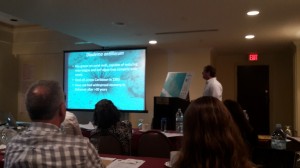
Representatives from local research, conservation and education organizations also discussed ways to implement national strategies on a local level throughout The Bahamas.The Plan will integrate island specific and national coral reef conservation, education, restoration, management and policy efforts. The Disney Conservation Fund supported the workshop, and the Bahamas National Trust are also looking to build strategic partnerships to maximize the benefits from existing funding sources and to collaborate to target additional funding for island specific and national projects.
Partners included: Bahamas Reef Environment Education Foundation, The Nature Conservancy, Department of Marina Resources, Save The Bays, Bahamas Agriculture and Marine Science Institute, Young Marine Explorers, Atlantis, Friends of the Environment, AGGRA, Shedd Aquarium, Andros Conservancy and Trust, and the New England Aquarium.
